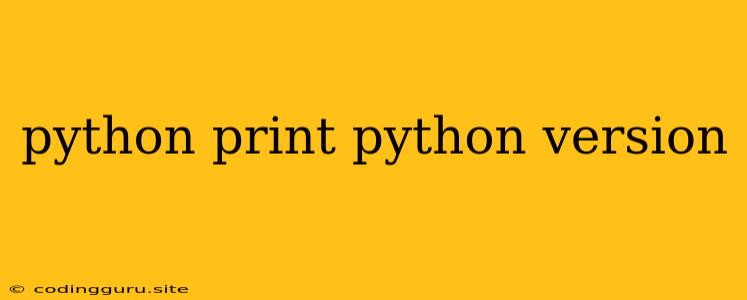How to Check Your Python Version
Python is a versatile programming language used in various applications. Knowing your Python version is crucial for many reasons, especially when working with different libraries and modules that may have specific version requirements. This guide will walk you through the simple steps to check your Python version on your system.
Why Is Knowing Your Python Version Important?
- Library Compatibility: Libraries and modules are often developed for specific Python versions. If you're using an outdated version, you may encounter compatibility issues or be unable to install necessary packages.
- Code Portability: When sharing or collaborating on Python projects, it's vital that all team members are using the same Python version to avoid conflicts and ensure seamless code execution.
- Bug Fixes and Security Updates: Newer versions of Python may include critical bug fixes, security enhancements, and performance improvements. Keeping your Python installation up to date is essential for maintaining code stability and security.
Checking Your Python Version Using the sys Module
Python's built-in sys module provides essential system information, including the Python version. Here's how to use it:
- Open your Python interpreter: Open a terminal or command prompt and type
pythonorpython3(depending on your system's default Python version). - Import the
sysmodule: Inside the interpreter, type:import sys - Print the version information: Type the following:
print(sys.version)
This will display the Python version, including the major, minor, and micro versions along with additional details like build date and platform information.
Example:
>>> import sys
>>> print(sys.version)
3.9.7 (default, Nov 17 2020, 10:18:21)
[GCC 9.3.0]
This output indicates that the Python version is 3.9.7.
Checking Your Python Version Using the python --version Command
An alternative method is to use the python --version or python3 --version command directly in your terminal.
Example:
$ python --version
Python 3.9.7
Checking Installed Python Versions
If you have multiple Python versions installed on your system, you may want to see a list of all available versions. Here are some tips:
-
Linux/macOS:
- Use the command
python --versionto see the default Python version. - For alternative Python versions installed using tools like
pyenvorconda, use the corresponding commands (e.g.,pyenv versions,conda env list).
- Use the command
-
Windows:
- Open the Start Menu and search for "python" or "python3".
- You'll see a list of installed versions.
Upgrading Python
If you need a newer version of Python, you can usually upgrade it through your system's package manager or by installing from the official Python website.
- Linux/macOS: Use package managers like apt, yum, or brew to upgrade Python.
- Windows: You can download the latest version from the Python website.
Maintaining Multiple Python Versions
If you frequently work with different Python versions, using tools like pyenv or conda for environment management can help you switch between versions seamlessly.
Note: The specific commands and methods for checking and managing Python versions may vary slightly depending on your operating system and how Python is installed.
Conclusion
Knowing your Python version is a fundamental step in any Python development workflow. The methods outlined in this article provide easy ways to check your current version and ensure compatibility with the libraries and projects you're working on. Remember to keep your Python installation updated to benefit from new features, bug fixes, and security patches. Happy coding!
